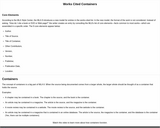
This LO explains how MLA 8 treats citations. It defines a “container” and explains how they are used.
- Subject:
- Composition and Rhetoric
- English Language Arts
- Material Type:
- Interactive
- Provider:
- Michigan Virtual
- Date Added:
- 12/11/2018

This LO explains how MLA 8 treats citations. It defines a “container” and explains how they are used.
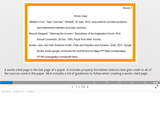
This LO introduces changes to works cited in MLA 8 and examines the connection between the works cited page and in-text citations.

This LO provides a review of the basic rules that need to be followed to create a works cited page for a variety of sources.

An ethincal look at good and/or bad business practices and innovative ways to address their challenges.
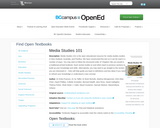
Media Studies 101 is the open educational resource for media studies studies in New Zealand, Australia, and Pacifica. We have constructed this text so it can be read in a number of ways. You may wish to follow the structured order of 'chapters' like you would in a traditional printed textbook. Each section builds on and refers back to previous sections to build up your knowledge and skills. Alternatively, you may want to go straight to the section you are interested in -- links will help guide you back to definitions and key ideas if you need to refresh your knowledge or understand a new concept.
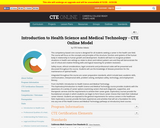
This competency-based core course is designed for all students seeking a career in the health care field. The course will focus on the concepts and principles of the structure, function and systems of the human body in relationship to human growth and development. Students will learn to recognize problem situations in health care settings as relate to direct and indirect patient care and they will demonstrate the use of critical and creative thinking skills and logical reasoning for problem resolution.Safety issues, ethical considerations, legal constraints and professional codes will be presented and discussed throughout the course. Students will use the knowledge of disease prevention for the maintenance of optimal health.Integrated throughout the course are career preparation standards, which include basic academic skills, communication, interpersonal skills, problem solving, workplace safety, technology, and employment literacy.

Unsure of how to invest your money? Whether to rent or buy? Or which career path is right for you? We've all asked ourselves these questions, and it seems that everywhere you turn the TV, radio, financial advisors, friends, and family someone has an answer. In this course we turn down the noise to bring you sound advice. With two seasoned economists as your guides, youll walk through what everyone needs to know about personal finance.
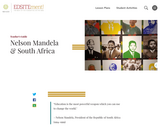
After more than 30 years in prison and an historic election that for the first time in the nation's history included all citizens regardless of race, Nelson Rolihlahla Mandela became President of the Republic of South Africa on May 10, 1994. This Teacher's Guide includes resources for teaching about the brutality of apartheid, the resilience of the nation's people, the leadership of Nelson Mandela, and primary source materials that will inform discussion about the country's emergence in the world.
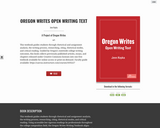
This textbook guides students through rhetorical and assignment analysis, the writing process, researching, citing, rhetorical modes, and critical reading. Guided by Oregon's statewide college writing outcomes, this book collects previously published articles, essays, and chapters released under Creative Commons licenses into one free textbook available for online access or print-on-demand.
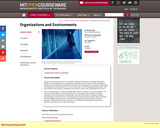
Examines theory and research on the relationship of organizations to each other and to their economic, political, and social environments. Classic and contemporary approaches to complex social systems, the dynamics of inertia and change, the role of legitimacy, and the production of change as an intended or unintended consequence. Considers the relative roles of voluntarism and determinism in the pursuit of organizational agendas and in the shaping of organizational environments, for example, with respect to changing employment relationships and environmentalism. Primarily for doctoral students. The goal of this doctoral course is to familiarize students with major conceptual frameworks, debates, and developments in contemporary organization theory. This is an inter-disciplinary domain of inquiry drawing primarily from sociology, and secondarily from economics, psychology, anthropology, and political science. The course focuses on inter-organizational processes, and also addresses the economic, institutional and cultural contexts that organizations must face. This is an introduction to a vast and multifaceted domain of inquiry. Due to time limitations, this course will touch lightly on many important topics, and neglect others entirely; its design resembles more a map than an encyclopedia. Also, given the focus on theoretical matters, methodological issues will move to the background. Empirical material will be used to illustrate how knowledge is produced from a particular standpoint and trying to answer particular questions, leaving the bulk of the discussion on quantitative and qualitative procedures to seminars such as 15.347, 15.348, and the like.
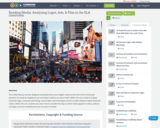
This media literacy unit was designed and piloted with junior English classes at the start of the school year. Activities can easily be adapted to suit secondary students at various levels. Within the unit, students analyze corporate logos, corporate advertising, movie trailers and stereotypes found in media related to Native American culture. Within the unit, students also learn how to consider the ways in which media appeals to ethos, pathos and logos and how to identify the tone of a piece of media.
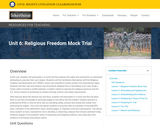
In this unit, students will participate in a mock trial that explores the rights and restrictions on individuals attempting to practice their own religion. Students will first familiarize themselves with the Religious Freedom and Restoration Act (“RFRA”), which was intended to further protect First Amendment rights. Students will then read and analyze case documents adapted from a real federal court case, Singh v. Carter, which involved a conflict between a soldier’s desire to exercise his religious practices and the U.S. Army’s interest in protecting its soldiers through uniform and safety requirements.
After learning about the relevant law and facts, students will participate in a mock trial that will allow them to use their knowledge to persuade judges to find either that the soldier’s religious practice is protected by RFRA, or that the Army has an overriding safety concern that forbids the soldier from exercising his religion. The mock trial allows students to assume roles as members of the plaintiff’s team, members of the defendant’s team, neutral judges, or impartial courtroom participants. This allows every student to have a substantive role in deciding or observing a dispute that remains pertinent today. Students engage in the authentic tasks of examining and weighing evidence, and using facts and evidence to formulate and present claims.
This Unit contains 7 lessons:
Lesson 1: Religious Freedom Mock Trial
Lesson 2: Articulating and Applying the Law
Lesson 3: Understanding the Evidence
Lesson 4: Developing a Theory of the Case
Lesson 5: Preparing for Trial
Lesson 6: The Trial
Lesson 7: Debrief and Reflection

This course combines classroom and community classroom instruction to prepare students for employment in the retail industry. Training will include elements of the sale, types of retailing, types of merchandise, customer relations, merchandising, pricing, inventory control, visual merchandising, operations, promotional elements, and human resources. Emphasis is placed on real world application of learning through work experience in the community. Employability skills emphasized include: preparing for employment, business attitudes, work habits and attendance.
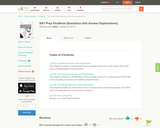
A free mini-book to prepare students for the SAT exam with lessons and questions in math, reading, and writing.
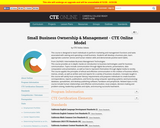
This course is designed to teach individuals to perform marketing and management functions and tasks associated with owning and operating a small business. Students will develop a business plan, learn appropriate customer service and human relation skills and demonstrate positive work habits.
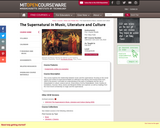
This course explores the relationship between music and the supernatural, focusing on the social history and context of supernatural beliefs as reflected in key literary and musical works from 1600 to the present. It provides an understanding of the place of ambiguity and the role of interpretation in culture, science and art. Great works of art by Shakespeare, Verdi, Goethe (in translation), Gounod, Henry James and Benjamin Britten are explored, as well as readings from the most recent scholarship on magic and the supernatural.

This Unit on the Foundation of American Government focuses on the founding of the U.S. government, the ideals of democracy, along with the historical influence of various government styles on the U.S. This blended government/civics unit and course offers elements of both face-to-face and interactive online learning.
https://docs.google.com/document/d/1G1NNqQgpOyvCt2Fe3v6TyHe3LSprGVd06HPPWh37j7o/edit?usp=sharing
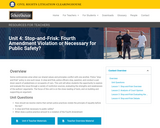
Some controversies arise when our shared values and principles conflict with one another. Police “stop-and-frisk” policy is one such issue. In stop-and-frisk, police officers stop, question, and conduct a pat-down search of pedestrians or occupants of cars. This unit will allow students the opportunity to explore and evaluate this issue through a variety of nonfiction sources, evaluating the strengths and weaknesses of the authors’ arguments. The focus of this unit is on the close reading of texts, and on building and supporting an argument.
This Unit contains 4 lessons:
Lesson 1: Stop-and-frisk Overview
Lesson 2: Analysis of Court Opinion
Lesson 3: Stop-and-frisk Evaluating the Positions
Lesson 4: Stop-and-frisk Debate

In 1870, the United States was primarily an agricultural nation. Most Americans made a living from farming. Flash forward fifty years and the United States underwent a major transformation as more Americans left farming in search of industrial jobs in cities.With the discovery and usage of raw materials, creation of new inventions, and expansion of big business; the Industrial Revolution transformed the American economy and the lives of millions of Americans.
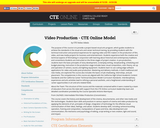
The purpose of this course is to provide a project-based visual arts program, which guides students to achieve the standards in the visual arts and career technical training, by providing students with the technical instruction and practical experiences for aspiring video and film makers in the production of film, video, and new media projects for business and entertainment. Students experience both the creative and technical aspects of filmmaking in conjunction with learning about historical and contemporary traditions and conventions.Students are instructed on the three stages of project creation. In pre-production, students learn the basic principles of story development, screenplay writing, storyboarding, scheduling and budget planning. Instruction in the production stage includes basic visual composition, color theory, set up and operation of camera, sound, and lighting equipment. Students learn to use cutting-edge software applications for video and audio post-production. Mastering and delivery methods, in both traditional and new media, are explored.The course also includes the basics of job shadowing, internships, and job placement. The competencies in this course are aligned with the California High School Academic Content Standards and the California Career Technical Education Model Curriculum Standards. Interdisciplinary experiences and arts activities lead to refining a personal aesthetic, and a heightened understanding of career opportunities in art and arts-related fields.